Wudongde Project Takes Hydro to New Heights
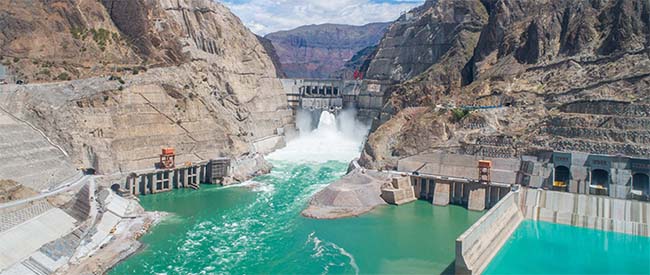
A multi-year, multibillion-dollar undertaking on China’s Jinsha River has achieved several “firsts” for the hydropower sector, earning POWER’s highest honor thanks to its development, design, and importance to the power generation industry. It also is a model in China’s push for more clean and sustainable energy.
China already was the global leader in hydropower generation before Xi Jinping, the country’s president, in 2020 announced a plan for the world’s most populous country to become carbon neutral by 2060. That strategy, backed by government policies in support of renewable energy as part of the overall plan to increase the electricity supply for China’s nearly 1.5 billion people, again put the spotlight on the country’s massive hydropower projects. China has more than quadrupled its hydroelectric power generation capacity since 2000; according to Global Data, a UK-based data analytics and consulting group, the country’s cumulative installed capacity of its hydropower plants was just shy of 380 GW as of year-end 2021, growing at a rate of about 2.6% year-over-year.
That total includes the Wudongde Hydropower Station, considered a major project in China’s “West-to-East” power transmission program. That transmission scheme, designed to move surplus electricity from western China to the more densely populated eastern part of the country, primarily is exploiting abundant hydropower resources in southwest China’s Guizhou, Yunnan, and Sichuan provinces. The power is being moved eastward to major population and business centers including Shanghai and Beijing.
Wudongde, built for an estimated cost of about $18 billion and owned by China Three Gorges Corp. (CTG), a Chinese state-owned power company, is notable for several reasons. It’s the first (by location) of a series of four cascade hydropower stations in the lower reaches of the Jinsha River (the Chinese name for the upper reaches of the larger Yangtze River), and with 10.2 GW of installed capacity, it is the fourth-largest hydroelectric project in China and the seventh-largest in the world.
The cascade project includes Wudongde, along with Baihetan, a 16-GW project that could be commissioned later this year. The other dams in the cascade are Xiluodu, a nearly 14-GW dam that has operated since 2013; and Xiangjiaba, a 6.4-GW power station that came online in 2014.
The Wudongde station, which entered full commercial operation in summer 2021, about a year after its first unit began producing power, straddles Luquan County in Yunnan Province, and Huidong County in Sichuan Province. It features twelve 850-MW units, with six supplied by Voith, and six supplied by GE Renewable Energy. The project, which took about five-and-a-half years to build, also includes structures for water retaining, water releasing, and water diversion, along with providing power generation.
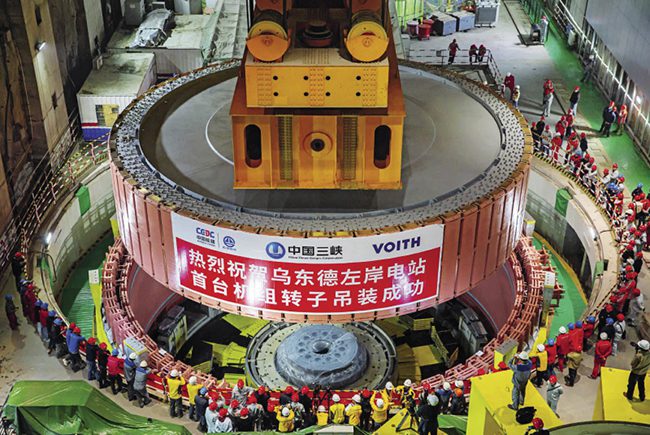 |
|
1. A ceremony attended by project officials and construction staff marked the installation of the first turbine, manufactured by Voith, on the left bank of the Wudongde project. The hydropower plant has 12 turbines, each with 850 MW of generation capacity. Courtesy: Voith Hydro |
At the time when Wudongde was put into operation last year, the project’s 850-MW Francis-type turbines were the largest single units in use in a fully operating hydro plant worldwide, according to Voith Hydro. Stephen Lewis, president and CEO for Voith Hydro for the APAC (Asia-Pacific) Region, told POWER, “As one of the major partners, Voith Hydro supplied six Francis turbine generating units, each rated at 850 MW, for the left bank (Figure 1) of the plant.” Lewis further noted that during the project’s five-plus-year timeline, “Over more than 2,000 days and nights of project execution, Voith Hydro had worked very closely with our long-term partner, CTG, to manage the various challenges in engineering, manufacturing, logistics, erection, and commissioning.”
Pascal Radue, CEO of GE Renewable Energy Hydro Solutions, in a statement last year after the plant entered commercial operation, said, “Congratulations to CTG and all the parties involved on the successful commissioning of all units of the world’s seventh-largest hydropower plant. Seeing these giant units now up and running makes me very proud.”
Radue continued: “In this way, we are consolidating the role of hydropower as the foundation of China’s future energy landscape. That our technology is helping China achieve its goals in reducing emissions and conserving energy is further evidence of the successful partnership that CTG and GE Renewable Energy have built over the past 30 years.”
World’s Thinnest Double-Curved Arch Dam
CTG has said the Wudongde project set eight world records during its construction, and achieved 15 “world firsts.” That includes construction of the world’s thinnest double-curved arch dam, with a crest elevation of 988 meters, a maximum height of 270 meters, a bottom thickness of about 51 meters, and height-to-thickness ratio of 0.19.
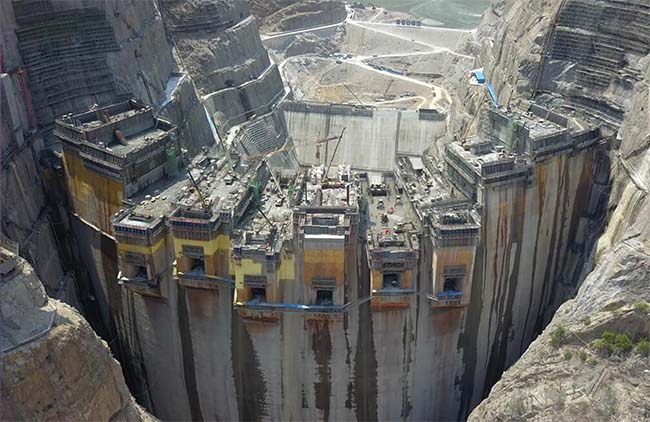 |
|
2. The Wudongde dam features notable engineering, including the world’s first-ever super-high arch dam poured with low-heat cement concrete throughout the entire body of the dam, according to Chinese officials. Low-heat cement is specially blended to provide a lower heat of hydration in concrete, which makes it ideal for mass concrete pours, where the rate of temperature rise and the maximum temperature achieved must be controlled in order to reduce the risk of thermal cracking. Courtesy: China Three Gorges Corp. |
The project includes notable engineering, including the world’s first-ever super-high arch dam poured with low-heat cement (Figure 2) throughout the entire body of the dam, according to Chinese officials. Low-heat cement is specially blended to provide a lower heat of hydration in concrete, which makes it ideal for mass concrete pours, where the rate of temperature rise and the maximum temperature achieved must be controlled in order to reduce the risk of thermal cracking.
The power station is sending electricity to the China Southern Power Grid, according to government officials, and supporting the development of the Guangdong-Hong Kong-Macao Greater Bay Area, along with other regions. The dam also is an important part of the Yangtze River Basin flood control system. The dam has a normal storage level of about 975 meters, with total reservoir storage capacity of more than 7.4 billion cubic meters.
Lewis said, “Voith was very honored to cooperate with Three Gorges, the world’s largest hydropower development and operation company and China’s largest clean energy corporation, in the construction of the Wudongde hydropower plant. The power station is a new benchmark for the construction of hydropower projects globally … furthermore, the smooth commissioning of the power plant is one of the most important milestones in the history of Voith Hydro.”
Economic Development
The Wudongde plant not only provides hydropower resources; it also contributes to China’s goal of what government officials have called “stable economic development.” The project is designed to optimize China’s renewable energy infrastructure, and support the country’s goal of raising the share of non-fossil energy consumption in the energy mix to around 25% by 2030.
Yang Zongli, director of CTG’s Wudongde Project Construction Management Division, told the state-run Xinhua News Agency the Wudongde project not only will help China achieve carbon neutrality by 2060, but will also promote development of the Yangtze River Economic Belt and boost economies across the region. With all 12 units operating, Wudongde can generate 38.9 TWh of renewable energy each year. Officials have said the station plays a major role in reducing China’s carbon emissions.
“China is already leading the world in the generation of electricity from hydropower and Wudongde is yet another demonstration of the investment that China is making toward a sustainable future for generations to come,” said Lewis. “After full operation, Wudongde hydropower plant can save 12.2 million tons of standard coal and reduce the emission of 30.5 million tons of carbon dioxide and 104 thousand tons of sulfur dioxide each year. These figures represent a significant contribution to environmental protection and further support the energy saving and emissions-reduction goals of the Chinese government.”
China’s National Energy Administration, citing industry statistics, on its website says the country’s total installed renewable energy capacity topped the 1,000-GW mark in 2021, accounting for 43.5% of China’s total installed power generation capacity (and about 28% of China’s actual electricity generation). The statistics showed that installed capacity percentage has jumped more than 10 points since 2015.
The People’s Bank of China (PBOC), the country’s central bank, in November of last year introduced a new lending facility to offer cheaper funding to banks to support financing of “green” energy projects, including renewable energy, energy efficiency, and carbon reduction technologies. Yi Gang, the PBOC governor, in a recent interview with state media Xinhua News Agency, said funds already are being issued to banks.
 |
China’s Hydropower History
Hydropower has long been central to China’s power generation. The country’s first hydroelectric plant was completed in Yunnan province in 1912, though the sector didn’t begin to ramp up until the 1980s, after the death of longtime ruler Mao Zedong. Deng Xiaoping, who ruled the country from 1978 to 1992, opened up the country through a series of political, economic, and cultural changes, with his government supporting investments in energy infrastructure.
Preparation for building the Three Gorges Project began in the 1980s, part of a broader government program to use hydropower to support the country’s economic development. The Three Gorges Hydropower Plant is the world’s largest hydroelectric facility, with 22.5 GW of generation capacity. All of Three Gorges’ 34 power units were connected to the grid on July 2, 2012, and the plant reached full-load operation on July 12, 2012 for the first time.
The dam at Three Gorges, though, is much shorter than the dam at Wudongde. Three Gorges sits about 181 meters, or 594 feet high, or about 90 meters shorter than the dam at Wudongde. According to Chinese officials, the primary function of the Three Gorges project is flood control, not power generation, so it is not always in full-load operation.
China is home to five of the world’s 10 largest hydroelectric dams by generation capacity, with Three Gorges far outpacing the rest. The world’s second-largest hydropower station is the 14-GW Itaipu Dam on the Paraná River, located on the border of Paraguay and Brazil. The aforementioned Xioluodu dam in China is third.
The largest hydropower station in the U.S. is the 6.8-GW Grand Coulee Dam on the Columbia River in Washington state, currently the world’s eighth-largest hydro facility in terms of generation capacity. The global list will be revised, of course, when the 16-GW Baihetan project in China comes online, perhaps as soon as later this year.
China’s nearly 380 GW of hydropower capacity is more than the total combined capacity of the world’s next four-largest countries when it comes to hydro—Brazil (109 GW), the U.S. (103 GW), Canada (82 GW), and India (50 GW), according to data from the International Energy Agency and the International Hydropower Association. China in March 2021 released its 14th Five-Year Plan for national and social economic development, with renewable energy in general and hydropower in particular being prominent pieces of the strategy.
The Beijing-based China Institute of Water Resources and Hydropower Research in a 2019 report wrote, “The total theoretical hydropower potential of China is 694 GW, about a 15% global share, and ranking first in the world. The technical exploitable installed capacity is 542 GW, a 17% global share, with a corresponding annual electricity generation of 2,474 TWh.”
Construction Benefits Community
Part of the effort to build Wudongde involved land requisition and relocating residents from the area of the construction site. China Today, a state-run media group, reported this actually provided better living conditions for some of those displaced. The news group quoted a relocated resident, Tian Taixue, as saying, “We used to live in adobe houses in a valley in Liangshan Prefecture, but now we live in multi-story apartment buildings. There were only bumpy dirt roads in my former community, now cement ones lead to each home. Life is much easier today,” said Tian.
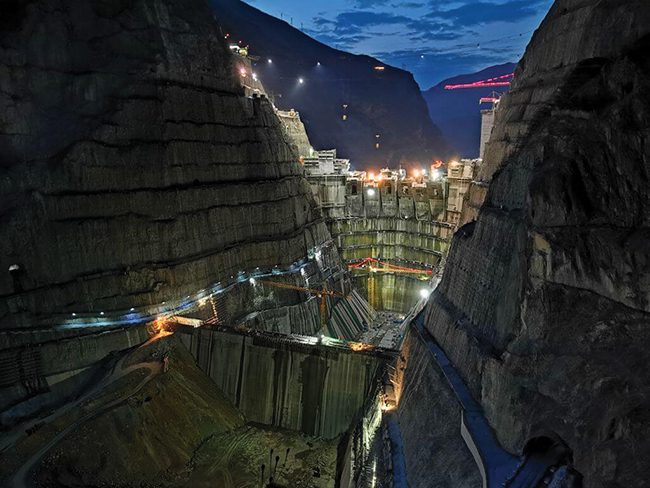 |
|
3. The years-long construction timeline for Wudongde meant workers often took on tasks at night, with lights needed to illuminate work areas. Voith officials said about 70,000 jobs were supported each year during construction. The dam took about five-and-a-half years to complete. Courtesy: China Three Gorges Corp. |
Voith told POWER that about 70,000 jobs were supported each year during the plant’s construction (Figure 3), and said “there will be nearly 360 full-time employees who take responsibility of daily operation,” for the Wudongde plant, with most of those employed by CTG.
The plant’s construction, like other power plant projects worldwide, was impacted by the coronavirus pandemic. Voith officials called 2020 “a crucial and decisive year for the construction of Wudongde,” characterizing the work that year as “arduous.”
Voith told POWER, “During the Spring Festival in 2020, COVID-19 virus swept across the country. According to the development of the epidemic situation, the China Three Gorges Corporation actively took defensive measures and scientifically organized onsite installation. Under the overall framework of the company’s epidemic prevention, Voith’s onsite personnel integrated into the onsite installation guidance and quality control work, and truly achieved the goal of ‘controlling epidemic situation’ and ‘grasping production.’ ”
Water Management
China’s massive hydropower dams also play a role in the country’s water management. Lewis told POWER, “Wudongde hydropower station is located on the mainstream of Jinsha River, which is rich in water resources. As a large-scale water conservancy project, Wudongde hydropower station not only generates electricity but also serves as a reservoir. It can store a large number of water resources and provide water for the lower reaches when Jinsha River enters drought conditions.”
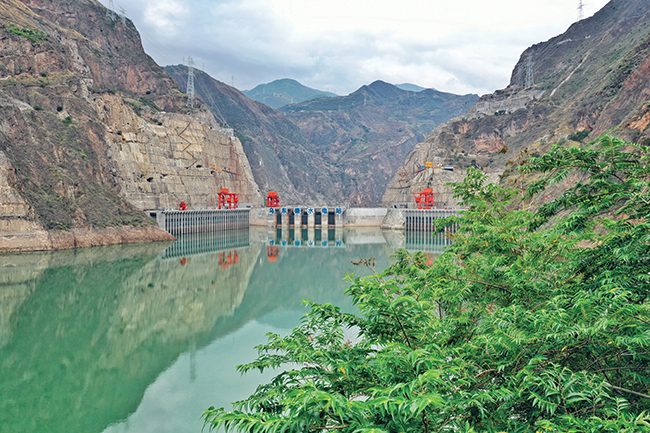 |
|
4. The deep water of the Jinsha River behind the Wudongde dam is promoting the reproduction of fish, and allowing the project to take a role in water management, including a reservoir that can provide water downstream during drought conditions. Courtesy: GE Renewable Energy |
Dam projects almost inevitably impact the environment for migratory fish, though CTG said construction of Wudongde has had some positive impacts. Officials said the dam slows down the river’s flow (Figure 4), and the river is now deeper, promoting the reproduction of fish. CTG officials told China Today that developers spent hundreds of millions of extra dollars to optimize the design of the project, using advanced engineering to keep the river’s environment for fish as normal as possible.
Zongli, CTG’s director of the Wudongde project, told China Today, “We recycle wastewater to irrigate slopes of more than one million square meters, and as a result, vegetation covers the former barren land. Besides, we have also bred and released rare and endemic fish in the lower reaches of the Jinsha River.” The director said a concept of “prioritizing ecological and green development” was used throughout the power station’s construction, including water and soil conservation, and ecological restoration, to strike a balance between environmental protection and hydropower development.
Project Contractors
The Wudongde project was done under the management of China Three Gorges Construction Engineering Corp. (CTGCE), a subsidiary of CTG. Gezhouba Group Three Gorges Construction Engineering Co. and Sinohydro Bureau 6 Co. led civil work during construction. Surveying and design work and project engineering for the project was led by CISPDR Corp. Voith Hydro and GE were in charge of electromechanical equipment. The power station is operated by China Yangtze Power Co.
A Voith official noted several of the project’s “firsts” when it comes to hydropower. Voith told POWER that the turbine of Unit 6, one of the half-dozen units supplied by Voith, “has a runner with a diameter of 9,900 mm [more than 32 feet] and a weight of [about] 450 tons. The runner diameter and weight rank first in runners ever manufactured onsite in the history of hydropower. The quality of welding seam, hydraulic profile, and dimensional inspection all passed the strict acceptance test and requirements of the flagship project standard. In the process of the static balance test of the runner, the runner met the top-quality requirement without the need for weight compensation and won the high recognition of the customer.”
Voith also told POWER, “The generator rotor of Unit 6 has a diameter of 17,500 mm [more than 57 feet] and a weight of 2,200 tons, and is one of the heaviest hydropower rotors worldwide. The overall roundness of the rotor as Voith delivered is far within the owner’s requirement and meets the owner’s high standard.”
Lewis added: “Voith Hydro fully met the owner’s high standards and implemented full-process all-round quality control at process steps of raw materials retesting, purchase, assembly, welding, machining, and painting. Such efforts have led to a series of high-quality components, which have won high remarks from the owner. All components meet the owner’s premium quality criteria, for example, stay ring, head cover, bottom ring, wicket gate, runner, main shaft, stator, and rotor parts.”
Lewis further echoed Chinese officials, stating, “Wudongde hydropower plant will play a very positive role in supporting the continued rapid economic and social development of both Sichuan and Yunnan provinces as well as the entire Yangtze River economic zone. The plant not only develops hydropower resources but also contributes to China’s goal of ‘stable economic development’ and optimizing China’s renewable energy structure.”
—Darrell Proctor is a senior associate editor for POWER (@POWERmagazine).